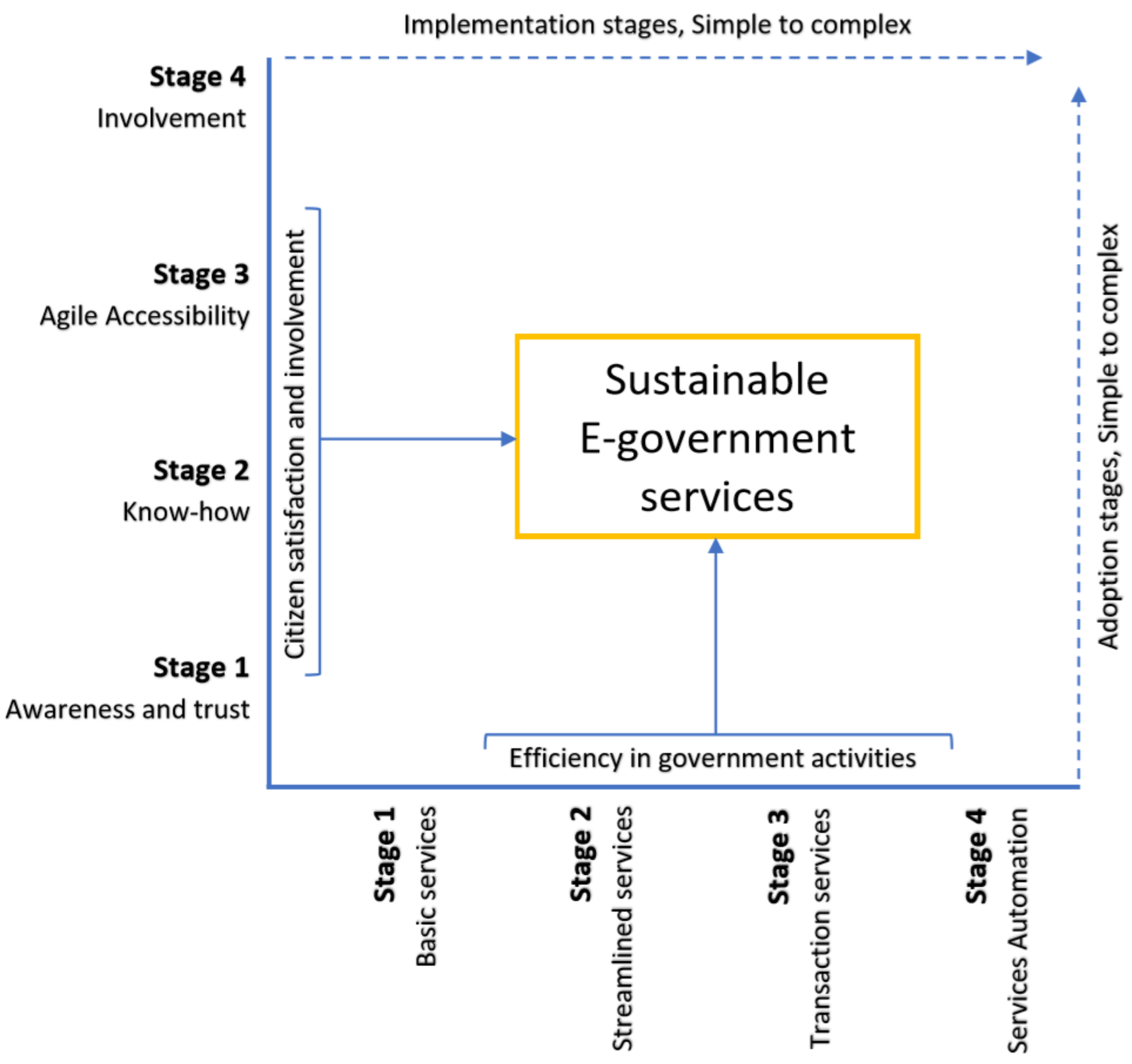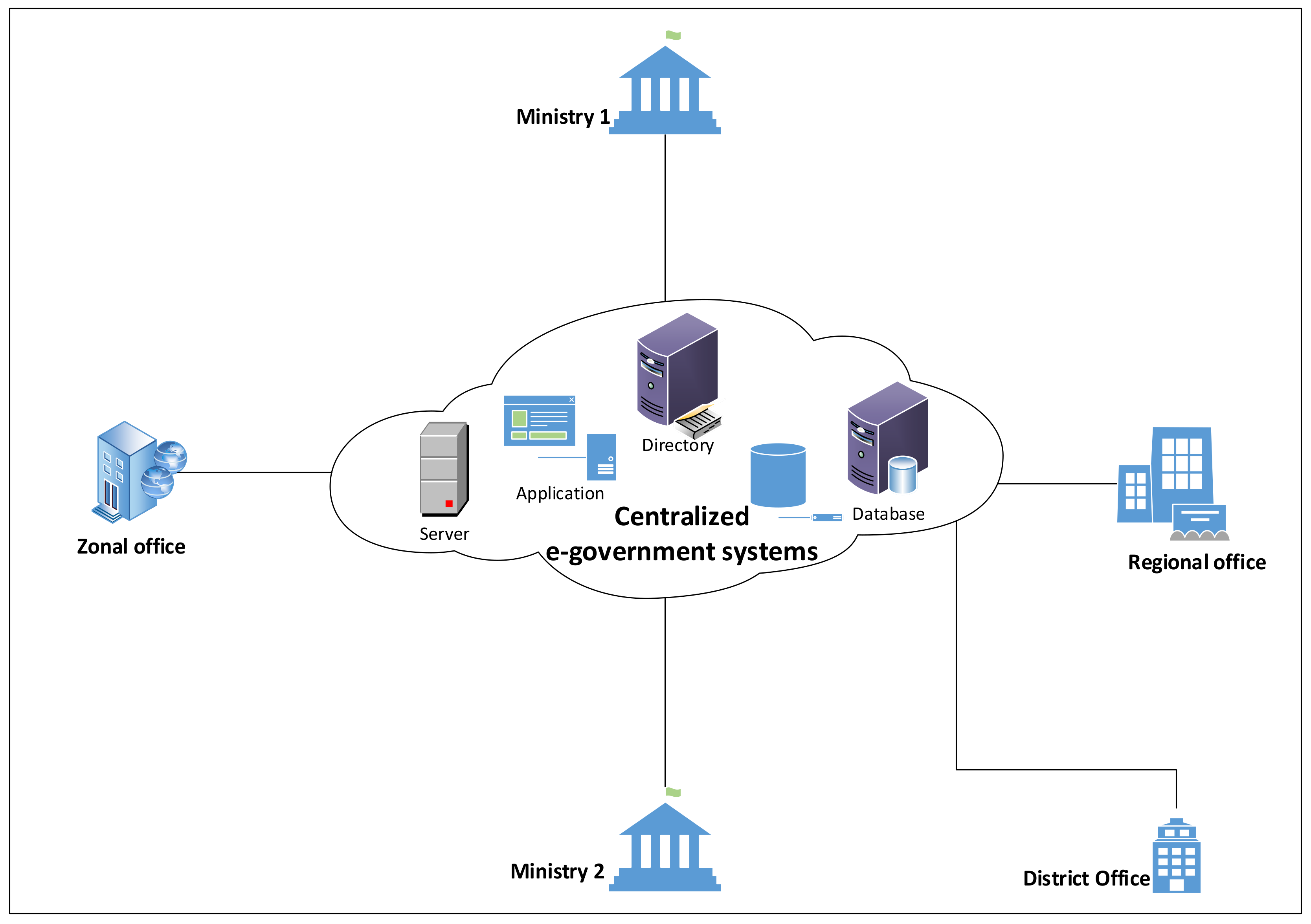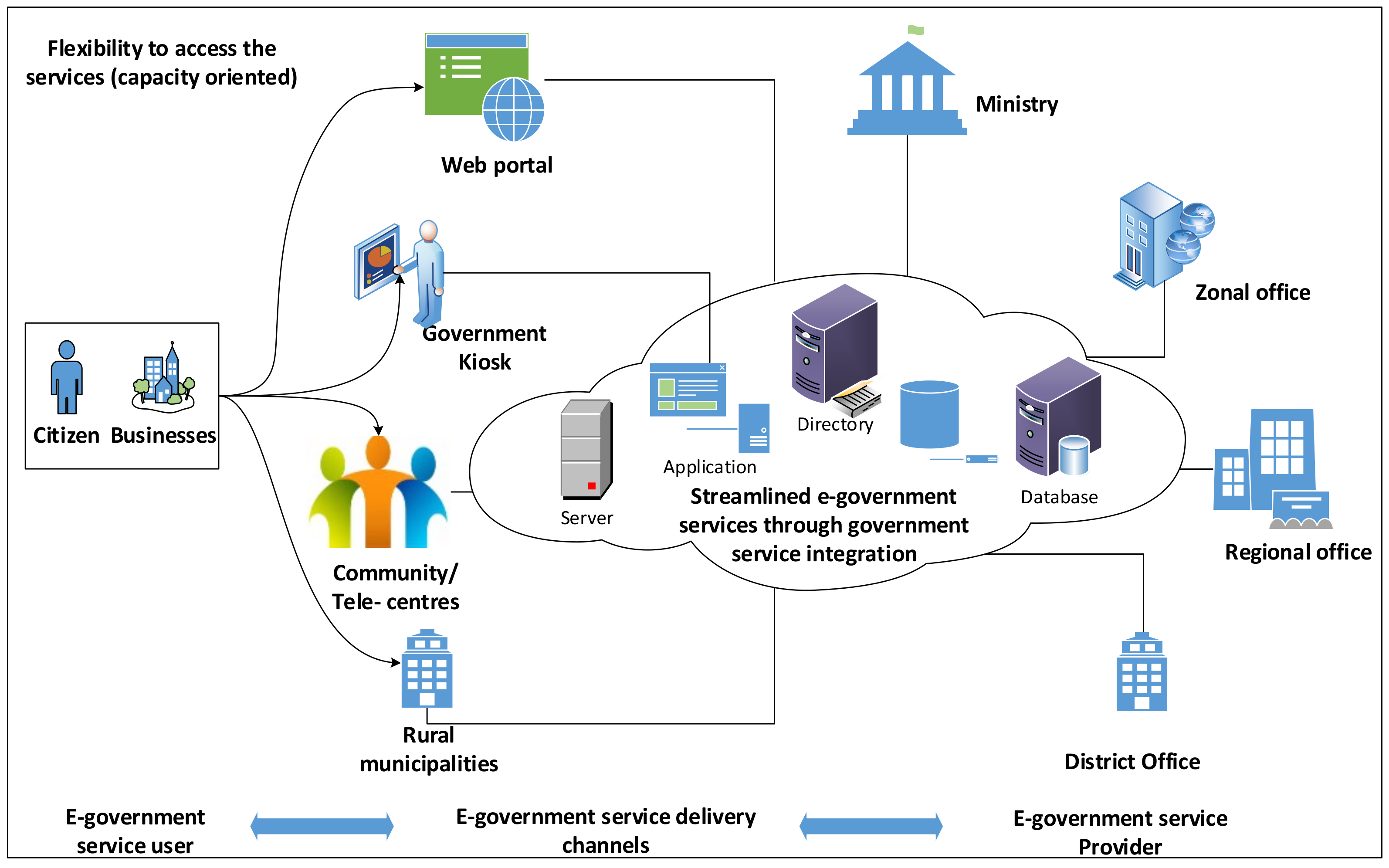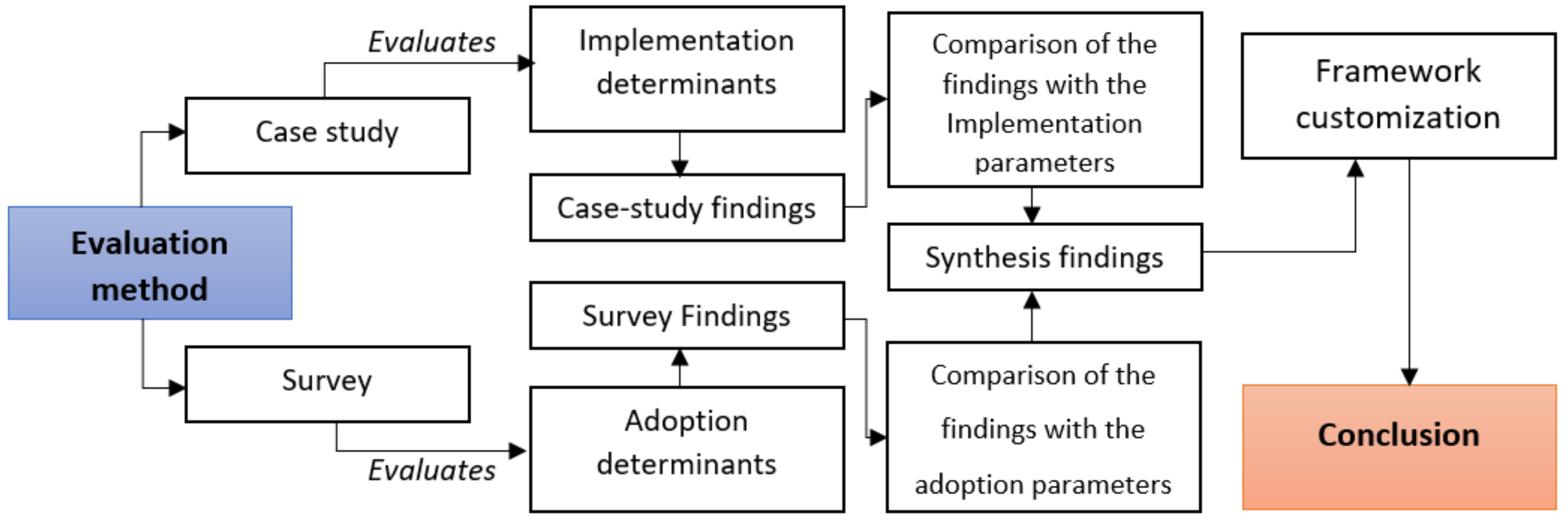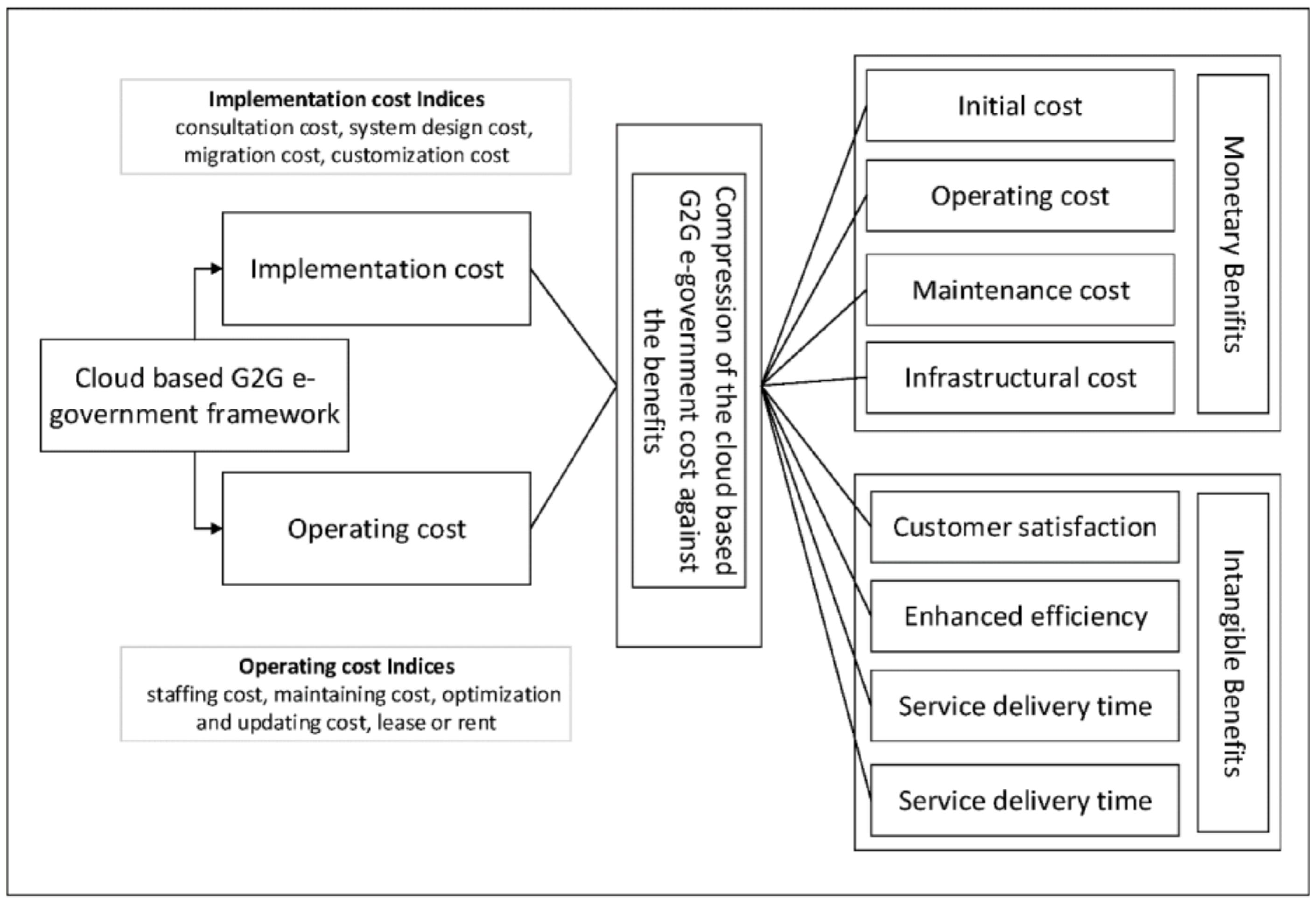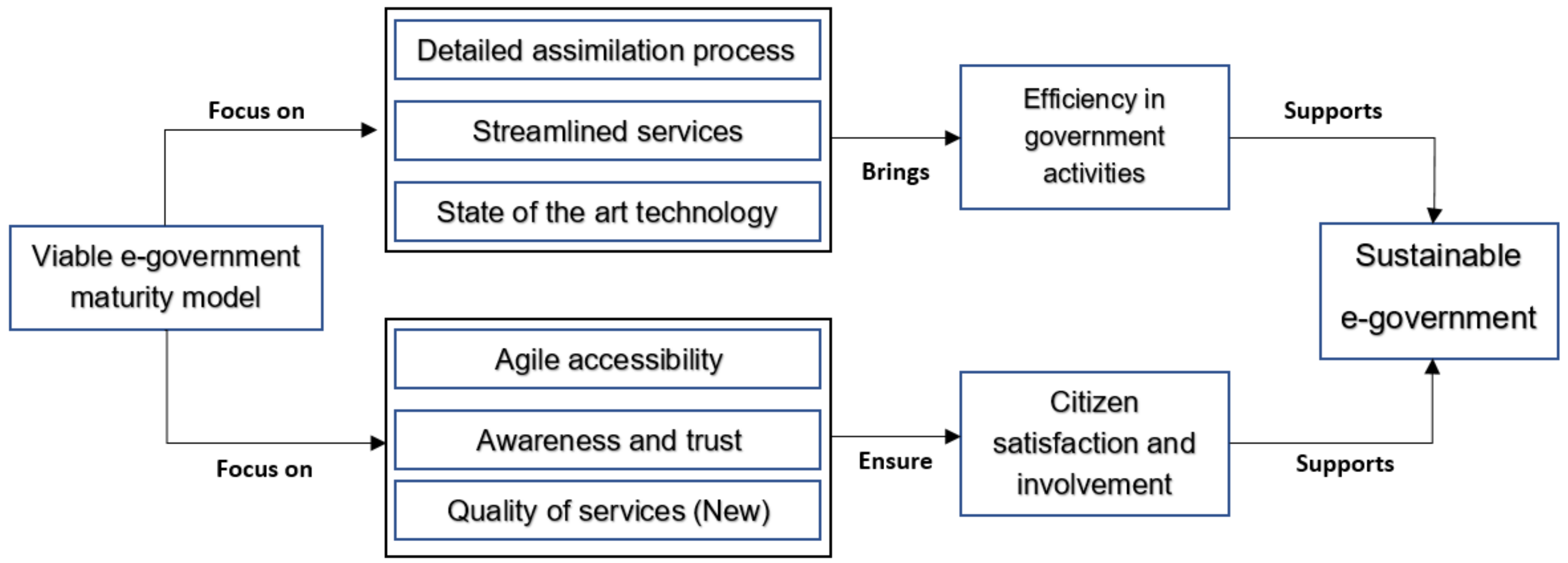We considered empirical investigations to evaluate the applicability of the proposed maturity model. In particular, as shown in
Figure 5, both the case-study and survey methods were used for this purpose. We defined evaluation parameters from the perspective of a sustainable e-government service, that is, cost, time, effort, and the adoption rate of offered services. The findings of the case study and survey were assessed against the set parameters to evaluate whether or not the proposed model was able to meet them. The rationale behind using two different methods of evaluation was the nature of the parameters required. The cost, time, and effort to implement e-government services was evaluated by employing a case-study, as it required actual implementation of the model in a real project. Meanwhile, customer satisfaction and adoption of e-government services was evaluated by the survey method.
6.1. Case Study
We adopted a case-study approach to validating the implementation determinants of a viable e-government maturity model. A case-study method is considered the best approach when data acquired from research needs be presented in a descriptive and explanatory way (Gillham [
38]). As we aimed to provide rationales for using the proposed model for sustainable e-government services, we adopted a case-study method, where we observed and recorded the opinions of participants while implementing the model in a real scenario.
6.1.1. Study Construct
The objective of the case study was to evaluate the defined determinants on the basis of their impact on sustainable e-government services. We argued that the inclusion of the determinants in the e-government maturity model provided governments an efficient approach to implementing e-government services. Therefore, we hypothesized the determinants as follows:
Hypothesis 1. The detailed assimilation process provided by the proposed maturity model would positively support governments in designing sustainable e-government services.
Hypothesis 2. The proposed maturity model would support governments in delivering streamlined services that result in a sustainable e-government.
6.1.2. Study Context and Rationales
The context of this study was the citizenship verification service in the government department regulating passports in Nepal. All Nepali citizens beyond the age of 16 are issued with a paper-based identity card called a citizenship certificate, which is proof of their nationality and is used to get various government services. These citizenship cards are issued by the District Administration Office and the Area Administration Office upon recommendation by local bodies, pursuant to the Citizenship Act, 2063 Bikram sambat (B.S.). The details of citizenship are held in their respective districts, and have to be manually fetched. Alternatively, users have to verify their citizenship cards from the districts they have been issued each time they require certain services (e.g., to get Nepali passport). This has become a critical issue for citizens residing far from home. These citizens must travel to their respective districts just to get verification, which is then brought to the ministry of foreign affairs prior to getting a passport. This process takes considerable time and cost, as transportation in various areas of Nepal is still a big issue. Therefore, we decided to contact the department for our case study, and to integrate a digital database of citizenship in various departments, so as to streamline the citizen verification process, saving both the government and the citizens time and effort. Nepal’s government also realized the need for a consolidated and centralized database of citizens, and took initiative to replace the old paper-based citizenship certificate with a new biometric card in 2010, and established the national ID management center in 2011. The government aimed to provide prompt and quality service to citizens at minimum cost, to maintain good governance, and to control crime in the society by introducing the national ID card. However, the project is not yet completed. As the department was seeking to streamline its data to achieve efficiency, the rationale for selecting them was to assess the proposed model for its applicability in achieving sustainable e-government services, involving the assessment of cost-saving, time-saving, and efficiency of government services.
6.1.3. Study Plan and Team
Firstly, we identified the maturity model adopted by the department to assimilate e-government projects. We had a formal discussion with the participants, and assessed the government plan available in its portal, and we found that the Nepali government had adopted a four-stage model, like Layne & Lee, for the assimilation of their e-government. Secondly, we identified the stage of e-government service maturity in the department. We assessed several government portals and the services they offered to determine the maturity level of e-government services. From the assessment, we found that the government achieved the first stage of basic services, according to the proposed maturity model. As the government had already achieved the first stage, we decided to initiate activities required to achieve the second stage, as defined by the maturity model. Once we gathered all the required information, we assembled a team to conduct the case study. As we had conducted a similar case study in a different department, we first approached government officials from that department to assist officials in the department regulating passports. After a few attempts, we convinced the officials to pilot the proposed model. However, they did not agree to test the model with their live system. We all agreed to replicate the e-government services, and reformed them as described by the proposed maturity model. We formed a team of government officials, e-government Information technology (IT) staff, and a local entrepreneur who provided us with technological support. The team members worked together to implement the maturity model, and observed the outcomes as the activities took place. The team members were allocated their roles in the case study. Government employees supported us by providing appropriate information required to assess the current e-government status, such as the system used, the model used, and other government data required while conducting the case study. The government IT staff and the local ICT entrepreneur performed technical tasks, such as system integration, customization, networking, etc.
6.1.4. Implementation Process
Once the study plan was formed and the required information was gathered, we started the activities defined by the proposed model. As we were implementing the proposed model in an existing e-government project, we first needed to assess the readiness of the country when it came to an e-government. E-government readiness refers to the organizational and technological capacity of a government to execute e-government projects. Organizational readiness for the adoption of an e-government is related to the legal framework for e-government activities, the availability of human resources, and the availability of the budget. Technological readiness refers to the available technology to implement e-government projects, the capacity of the people to adopt the offered e-services, and reliable connectivity. The assessment process involved discussions with the government officials, assessment of the data from internet service providers in the country, and analysis of previous study findings from various organizations. From the assessment, we found that the Nepali government had introduced many laws over the course of the last decade, in relation to e-governments, and information and communication technology. Appropriate measures had already been taken to reform the process of service delivery in the government. Organization and computerization of most of the government offices had already been done. Twenty-seven government ministries had digitalized their day-to-day work. Almost all district headquarters were connected to the internet, although connectivity remained an issue. From the findings, the participants agreed that the government of Nepal had achieved the basic level of e-government readiness, and was continuously improving its capacity toward advancement. The participants also agreed that a lack of access to technology, education, and awareness among citizens was an issue when it came to adoption. Therefore, the proposed maturity model became more relevant in the given context, as the model accommodated the adoption stages, which defined how a user could adopt the offered services. As the findings of the assessment suggested that the Nepali government had achieved the first stage of the implementation of e-government services, we decided to initiate the second stage of the proposed maturity model. Meanwhile, we found that the e-government services offered by the government had failed to attract users. Therefore, we decided that the adoption stages were to be started immediately. The case study was limited to the implementation of the second stage of the maturity model, as it was not practically viable to implement all stages. Furthermore, since we defined sustainability as efficiency in the delivery of government services, and the adoption of those services, we could mostly achieve this in stage two. The other stages can be achieved as the government moves toward more advanced technology, and gradually makes progress. These stages can be further evaluated in future research.
Implementation Stage 2: Streamlined Services
As decided by the participants, we started with the second stage of the maturity model. Unlike other maturity models (transaction in the second stage), the second stage of the proposed model was the streamlining of services, which could be achieved through the integration of government departments. The integration of government systems in various government departments is a complex task. In relation to the Nepali government, the servers of various government departments were co-located. However, integration still needed to be done. Furthermore, various layers of individual government departments had not even been integrated, creating data isolation problems. The same problem existed in relation to the citizenship data. The data was individually held in various offices, and required manual communication to various departments. This took time, and resulted in poor efficiency of the service, and poor customer satisfaction. As defined by the proposed model, we performed various activities to achieve streamlined services.
The first task towards achieving streamlined services was to enhance networking and connectivity between government departments and offices located in various geographical locations. The government departments had already recognized the need for better internet connectivity and networking between them for seamless communication. As an effort to enhance internet connectivity, Nepal successfully implemented a fiber-optic network with China in 2018. The government believed that the fiber-optic connection between Nepal and China would increase the reliability and speed of the internet connection, and minimize the dependency on internet networks connected solely via India. In relation to internet access between government offices located in various districts, Nepal had successfully connected 55 of the 75 districts with the optical fiber network in 2017. Similarly, remote government offices had been connected to the central office through Code Division Multiple Access (CDMA) and third generation (3G) networks. However, these efforts were not enough to achieve sustainable e-government services. For this to be the case, the government should speed up the process, and prioritize the task of networking and connectivity.
Interoperability is the one of the issues faced in developing countries. As various government departments develop their own system to digitalize their work, the integration of these systems becomes challenging. Therefore, we assessed the e-government initiative of Nepal to assess whether the government had established an interoperability framework to bring uniformity among government systems. We found that the government of Nepal had recognized its importance and had established an interoperability framework. The final draft of the e-government interoperability framework, known as the Nepal E-Government Interoperability Framework (NeGIF), was introduced in 2010. The government defined interoperability in three dimensions: business processes and organizational interoperability, information or semantic interoperability, and technical interoperability. The government introduced various standards and guidelines for applications, databases, networks, security and firewalls, document types, and all other technological aspects for all government departments and agencies. All government agencies and departments must follow these standards and guidelines while developing their systems. In addition, the Nepali government had developed its enterprise architecture (EA) framework which defined different components of the government, and how sub-architectures and government systems should be designed to achieve interoperability.
Some of the critical factors in achieving the integration stage of streamlined e-government services are cost and technology. Physical integration of e-government systems was becoming complex as many government offices in rural areas did not have access to reliable internet connectivity. Therefore, as defined by the maturity model and lessons learned from the previous case, we put forward a cloud-based solution for the integration and hosting of new applications.
Firstly, we conducted a cost–benefit analysis to compare the costs of existing e-government implementation and integration methods with cloud-based e-government implementation and integration. We aimed to analyze how much the department could save by adopting a cloud platform for its computing needs, and to deliver e-government services. We used the cost–benefit analysis template as shown in
Figure 6, designed for the previous study while performing the implementation of the cloud-based framework.
We studied government accounts to determine expenditure of procuring, managing, and operating the e-government systems. We found that the department was allocated a budget every fiscal year for the infrastructure and enhancement of information and communication technology. The budget covered procurements of hardware and software, salaries of technical staff, training expenses, maintenance costs of hardware, the internet lease, and server co-location. We summed the amount that the department spent in one year on information and communication technology, and compared that with the cost the government would incur upon adopting a third-party cloud-computing platform to implement and integrate the existing e-government system. We found that the government would be able to significantly reduce the cost by adopting a cloud-computing platform.
Secondly, we compared the time and human resources the department would require to integrate various data sources using traditional integration technology with cloud-based integration. We found that many of the government offices and departments in rural areas were still facing connectivity problems, with physical networking between databases getting increasingly complex and time consuming. Despite the government’s efforts to connect rural government offices, it seemed that the government would require a lot more time to accomplish connectivity. On the other hand, the migration of databases located in various offices, and their integration into a cloud would be achieved in less time. This integrated database would be accessible by any office at any time. This provided a clear picture of how the government could save time and cost by adopting a cloud-based implementation and integration of e-government services.
Adoption Stages 1–2: Enhance Technical Skill and Trust
Technical know-how among users is the most desirable condition to achieve citizen participation. We conducted two technical workshops on how to use government services, and two seminars on the benefits of using e-government services. The workshops were conducted by the IT staff responsible for e-government services. Participants included government employees from local government offices, and residents invited through the distribution of leaflets. Workshop participants were given in-depth training on how to use the services. The participants were distributed leaflets providing basic information about the government portal, names of various government services available online, and contact details of the help and support team.
The seminars were organized by government officials for residents to convey the e-government initiatives taken by the government, the available e-government services, the benefits of those services, and the future plan. The seminars were informative, with an hour of interactive question–and-answer sessions conducted at the end, for the benefit of the participants. Their opinions were noted by government officials. The workshops and seminars proved a milestone in increasing the know-how of participants, while the opinions and concerns of participants helped officials rethink how the offered services could be realigned with the citizens’ needs. Government officials found the workshops and seminars to be an effective way of increasing the know-how among the people, and decided to organize them more frequently at the local level.
Adoption Stage 3: Establish the Delivery Channels
The final task performed to achieve streamlined e-government services was to establish their delivery channels. We analyzed the probability of using various delivery channels defined by the proposed model in the given context. As the adoption of the delivery channels was subject to availability and feasibility, those adopted in this context may not be appropriate for other countries. We assessed various delivery channels, such as telecenters and government kiosks, which had been successfully adopted by other developing countries, such as India and Pakistan. After a brainstorming session among participants, we found that these delivery channels did not fit in the Nepali context. Therefore, after discussions with government officials, we all agreed that the most feasible option was to use rural municipalities and local libraries as delivery channels for e-government services. The decision to adopt rural municipalities and local libraries as delivery channels was made based on the feedback we received from participants in a previously-conducted seminar. Most of the participants demonstrated concerns in relation to the reliability of e-government services provided through kiosks, due to a lack of the technical skills required to operate the kiosks, and potential risks of exposing sensitive information in telecenters. Therefore, the rationale for selecting rural municipalities and local libraries was to achieve efficiency in government services while assuring users of the integrity of their confidential information.
6.1.5. Observations
We made several observations, and recorded the opinion of participants during the case study, which was presented using content analysis. Content analysis is used in qualitative research to categorize, classify, and summarize qualitative data (Neuendorf [
40]). We found that streamlined services could be achieved by adopting the proposed model. We also noticed that the transaction stage could not be completely achieved without the integration of government departments. Therefore, the integration stage coming before the transaction stage, as suggested by the proposed maturity model, was justified. We summarized the observations as described below.
- i.
Detailed assimilation processes minimized risk and provided better strategies of implementing e-governments.
During the case study, we had many formal and informal discussions in relation to the processes and activities defined by the maturity model. We also had discussions about the four-stage maturity model that was initially adopted by the Nepali government in order to develop its e-government projects. We found that, although the Nepali government had already performed many activities and achieved the goal defined by the proposed model, it had not been able to achieve its aim in the absence of a detailed assimilation plan. The case-study participants were impressed by the detailed activities and processes defined by the proposed maturity model. They found the detailed activities very helpful in understanding the requirement for achieving each level of maturity, and for planning the next level. “… the activities defined by the model are supportive to the development of appropriate strategies to implement e-government services, and would save us time and effort” (participant 1, e-government employee). Case-study team members from the government IT department thought that the systematically arranged activities under each stage in the proposed model would bring more clarity for the government. “..the activities defined by the model are useful and support the government to pre-plan for the next stage. The pre-defined activities also save the government a lot of time that is required when designing implementation strategies” (participant 2, government IT expert). One government employee stated that the naming of the stage, based on the service maturity rather than the technological maturity, supported the government in the comparisons between the project outcome and the aim of the e-government. Although the service maturity was the result of the applied technology, they found it easy to understand, in terms of the service delivery. “… the stage names, based on the service maturity, will help the government assess their project based on the accomplishment of the service, and help the government explain the achievement to various stakeholders in non-technical terms” (participant 4, government employee). The above findings positively supported the first hypothesis, which said that maturity models should have detailed assimilation processes to support the government in designing sustainable e-government services.
- ii.
Streamlining services through integration improved efficiency.
We found that various government departments adopted a government-to-citizen approach to the e-government, where certain services (e.g., the download of application forms, application status checks, the checking of exam results, etc.) were offered by specific departments. However, no services were effective as they required users to visit government offices to complete transactions. The case-study findings showed that the proposed model supported the government in achieving streamlined government services within the department. The integration of various e-government systems located in various geographical locations was done so as to form a consolidated system that allowed rural municipalities to deliver various government services using less time and effort. The case-study participants agreed that efficiency of government processes was achieved through streamlined e-government services. The manual processing of information was eliminated, enabling government employees in rural municipalities to make immediate decisions, and to process user requests in real time. This resulted in more efficient work. Furthermore, the integration platform as a service performed well, and it was found that the government would save costs, and would require less effort to integrate and implement e-government services using a cloud-computing platform. However, the availability of the cloud-computing resources and their reliability in the context of Nepal remain an issue. Therefore, the government needs to take an initiative to establish a cloud infrastructure, or to develop appropriate laws and policies in relation to the use of private or public clouds for the delivery of e-government services. Having said that, the cost–benefit analysis showed that the cost of establishing the cloud was expensive, making it less feasible in the context of developing countries. However, the overall operating cost once the cloud infrastructure is established was found to be very low in comparison to the cost of traditional e-government projects. Regardless of the issues in the integration of government systems, it is desirable that integration should be done before the transaction stage begins, so as to streamline e-government services. One of the aspects we considered for sustainable e-government services was efficiency, in terms of cost, time, and efforts. This was achieved by adopting the proposed model. Therefore, the second hypothesis, which stated that the proposed model supported governments in delivering streamlined services resulting in their sustainability, was proven true.
- iii.
Use of state-of-the-art technology was essential for sustainable e-government services in developing countries.
We observed that the use of state-of-the-art technology to implement and deliver e-government services increased government productivity, while allowing governments to reach a wider number of e-government service users. The proposed maturity models suggested various activities at various stages that emphasized adopting state-of-the-art technology (e.g., having a social media presence in the initial stage, use of shared computing resources among government departments through cloud-computing platforms and the like, use of cloud-based integration for streamlining services, and use of e-wallets for transaction processing). Moreover, the use of state-of-the-art technology in e-government activities was found to be cost-effective in comparison to older technologies, supporting the sustainability of e-government services. The unofficial Facebook page that was set up as a part of the case study, for the administrative office of the district of Kailali, received more than 20,000 likes over the course of a week. Users wrote their views, requests, and complaints about government services on the page. Government officials found it very useful in designing citizen-oriented approaches to service delivery. Furthermore, it made communication more transparent and clear between government officials and citizens. Finally, the integration of the databases of two administrative offices in the districts of Kailali and Kanchanpur was achieved through the use of cloud-based integration, resulting in greater efficiency.

